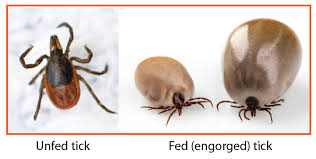Flea Facts & Tick Talk
 Dr. Marty Becker
Dr. Marty Becker
Animal Radio Veterinary Correspondent Dr. Marty Becker is back to help you keep your pets flea-less and tick-less. The good doctor has the ugly truth about how ticks infect you and your pet with a multitude of nasty viruses. And are fleas becoming resistant to spot-on preventatives?
Dr. Marty Becker has been a veterinarian for over 35 years and admits he still hates ticks. He says just seeing them on an animal, all engorged and blown up, is disgusting!
Years ago, when Dr. Becker fist became a veterinarian, it was like chemical warfare just to treat fleas and ticks. There were just dips, powders, sprays and collars. He states that while now it is easier to treat for fleas and ticks, it is also harder. This is because fleas have proliferated and we don't know when they are going to spring up, because of all of the different weather changes.
Regardless, we want to use the latest technologies in flea control to keep our pets "relatively" flea free. This is because depending upon where you live; it is not easy to keep your pet 100-percent free of fleas. It is especially harder along the coasts and in the south.
But what do you pick for your pet? If you go into any pet store or store that sells flea control, you can expect to find all sorts of tantalizing ads and competing claims, "This one works better," "This one's available at your veterinarian," "This one's an oral," etc. It's hard enough for veterinarians to keep it straight about which one works best, so how can you know!
The best thing is to visit or call your veterinarian and ask him what he actually uses on his own pets. Don't be afraid to let him know that you are going to buy your flea control at your local grocery store or even online. Just ask him what you can buy at these places that is going to work the best.
 Another thing to consider is the lifestyle of you and your pet. For example, if your pet is a heavy swimmer, you probably don't want to use a topical. It would be best to use an oral in this case. An oral would also work best if you have a lot of young kids around.
Another thing to consider is the lifestyle of you and your pet. For example, if your pet is a heavy swimmer, you probably don't want to use a topical. It would be best to use an oral in this case. An oral would also work best if you have a lot of young kids around.
If you have fleas and ticks, you want a product that takes care of both. Or, you can get a product that takes care of the fleas and then add a tick collar.
Just one flea can cause flea allergy dermatitis. When you see one flea on your pet, don't believe that it is a small problem. In one month, that sole flea can fill your house with thousands of descendants. For every flea you see on your pet, there are hundreds of eggs, larvae, pupa and emerging fleas that are in your yard, in your house and even in your car.
To keep these pests at bay, you should always use medication year round and not just during the summer months.
There has also been a long-standing rumor that fleas and even ticks have now become resistant to the medications that we use on our pets. Dr. Becker tells us that it is more of an Internet rumor than it is reality. He does state, however, that there are some areas that have resistant pockets, but it is not a major concern yet.
Ticks are from the arachnoid family so they are part of the spider family. They are eight-legged and they feed on blood. They suck bright red blood from your pet and then expel dark digested blood out their back ends. Ticks almost always have more than one bacterium or protozoa inside of them. So when a tick is feeding, they pump these into your pet's bloodstream. These can include Lyme Disease and Rocky Mountain Spotted Fever, which are then transferred to your pet.
There have been many folklore ways to remove ticks over the years. These include hot matches, cigarettes, Vaseline and mineral oil, which should all cause them to repel. The reason you don't want to do that is because it often causes the tick to regurgitate into the bite wound. Think of that little mouthpiece releasing all of the nasty bacteria and other disease causing agents, right into the wound.
 Instead, you should use forceps or tweezers. You can also buy a tick removal tool at most pet stores. If you don't have any of these, you can even use needle-nosed pliers.
Instead, you should use forceps or tweezers. You can also buy a tick removal tool at most pet stores. If you don't have any of these, you can even use needle-nosed pliers.
Just make sure you grab the tick really close to your pet's skin, next to its mouthpart. Then just use real steady rearward traction to pull them out. Make sure you wear gloves in case it bursts, so your skin is protected from the gut contents, and then flush them down the toilet.
If your dog is covered with ticks, it is best to take them to your veterinarian and let them do a safe removal.
Visit Fear Free Happy Homes for tips on making your home fear free and to locate a Fear Free Veterinarian near you. Go to Fear Free Pets to become certified.
Listen and Explore the Fear Free Expert Series
"HERO PEOPLE OF THE WEEK" - Alyssa Carter
 Our Hero Person this week lives in Johannesburg, South Africa and she's Alyssa Carter, who parlayed her love for Rhinos into fundraising to keep them from being poached. She even raised $23,000 by selling candy and trinkets to schoolmates and family.
Our Hero Person this week lives in Johannesburg, South Africa and she's Alyssa Carter, who parlayed her love for Rhinos into fundraising to keep them from being poached. She even raised $23,000 by selling candy and trinkets to schoolmates and family.
Alyssa Carter fell in love, even though she was only 6-years-old. Years later, the love of her life is still the Rhinoceros. But why rhinos? "I like their long horns and they're very nice and beautiful," explains Alyssa. She even has many stuffed Rhinos at home.
Alyssa's love of Rhinos started when she learned about endangered species in school. One of the animals that they talked about was the Rhino and how it was being poached.
The Rhino is still being poached for its horns, which is believed to have medicinal powers. The injustice is that it has no use whatsoever. It is primarily made up of keratin, the same material found in your fingernails and hair.
Alyssa decided she wanted to do something to save this beautiful animal. She started a campaign called "Alyssa's Save The Rhinos," and raised over $23,000 by selling chocolates and other candies, as well as stickers, to her classmates, friends, neighbors and relatives. Another organization trying to save the rhinos gave Alyssa a variety of jewelry to sell to help raise more money for her cause.
 Alyssa saw a video presentations by a group called the SANParks (South African National Parks) Honorary Rangers, who came up with the idea of putting sniffer dogs into the national parks to track poachers that come into the parks. After seeing this, Alyssa told her dad, "That is what I want to do. That is what I want to buy!"
Alyssa saw a video presentations by a group called the SANParks (South African National Parks) Honorary Rangers, who came up with the idea of putting sniffer dogs into the national parks to track poachers that come into the parks. After seeing this, Alyssa told her dad, "That is what I want to do. That is what I want to buy!"
Dad, Brian Carter, tells us that this whole idea was Alyssa's. They never sat her down and helped her come up with any ideas; she formed them all on her own.
The Carter family is made up of nature lovers who enjoy visiting the wildlife parks in South Africa, but Brian states that his family wasn't involved in conservation before Alyssa started her campaign. Now whole family has caught the young activist's enthusiasm.
Visit Website
How To Achieve Litter Box Success - Dr. Debbie
 It's important to realize not all cases of inappropriate elimination are a "behavior" problem. In confirmed behavioral driven house soiling cases, 20-percent of the cats also had a contributing medical condition at the time. So even if it sounds like a behavioral problem, see your veterinarian to ensure your cat isn't the 1 in 5 that has discomfort, infection, or other health problems influencing her litter box use.
It's important to realize not all cases of inappropriate elimination are a "behavior" problem. In confirmed behavioral driven house soiling cases, 20-percent of the cats also had a contributing medical condition at the time. So even if it sounds like a behavioral problem, see your veterinarian to ensure your cat isn't the 1 in 5 that has discomfort, infection, or other health problems influencing her litter box use.
Drawing Kitty To The "Right" Spot
Check the condition of the box - is it urine stained on the bottom? Throw it out and get a new one. Keep the box clean by scooping twice daily and by performing a complete litter change out twice a week for non-clumping litter or every 2-3 weeks for clumping varieties.
To entice kitty back to the litter box try a litter box attractant like the herbal-based cat litter additive called "Cat Attract."
Multi-cat homes, or those with outdoor cats nearby, should use pheromone (scent hormone) products to ease social stress and facilitate litter box harmony.
Kitty Eliminates Near, But Not Quite In The Litter Box
Your kitty is telling you that she understands what you want her to do, but something isn't quite right in the litter box environment. First start with providing a larger box, even if this means buying a plastic under bed storage box for this purpose. Look for one 18 x 36 inches in size.
Remove any litter box covers. Revisit the traffic flow in the litter box area. Ensure the box is in a quiet, low traffic area. Keep the box unquestionably clean.
Is Your Cat Urinating In Tubs Or Sinks?
Chances are your cat has urinary tract inflammation or infection. The cool surfaces provide relief to the inflammation or discomfort of a medical condition. See your veterinarian for a urine evaluation and treatment since environmental changes alone will not stop the behavior.
To preventing further episodes, decrease access to tubs and sinks, close doors to bathrooms, or fill the bottom of sinks and tubs with a small amount of water.
 Kitty Eliminates On Throw Rugs And Won't Use Litter Box
Kitty Eliminates On Throw Rugs And Won't Use Litter Box
Your cat has already made a litter preference. Perhaps the texture of carpet is more appealing than the litter used. Provide a litter box smorgasbord. This is when you provide multiple litter pans at the same time, each with different litter varieties such as clay, clumping, and natural pine litter. Be sure to include one litter box with sections of throw rugs or carpet remnants lining the bottom. During this time, remove all throw rugs from the house or block kitty's access to those areas.
If kitty demonstrates a litter preference, switch her litter boxes to that style of litter.
If kitty chooses the rug-lined box, then continue providing carpet lined litter boxes to establish a good pattern of repeated box use. Gradually start sprinkling small amounts of cat litter in the box on top of carpet surface. With time, many cats can be retrained to accept the box as the carpet is phased out and just litter remains.
Prevent Returning To Scene Of Crime
Clean all house soiling accident sites with an enzyme based pet cleanser. The enzymes break down the chemical component of the odors and do more than just cover up with scents. Do not use ammonia based cleansers on accident areas - doing so is counterproductive. (Remember that urine contains ammonia products.)
Cats dislike eating in areas that they eliminate, so place food and water bowls in the site of the accidents, or try placing pieces of aluminum foil in areas to deter kitty's use.
Citrus scents are offensive to cats and can be an effective cat deterrent. Use citrus or potpourri scented air fresheners in the area. If your cat is eliminating in house plants, place lemon or orange peels in the pot to make the area less attractive. And of course, make sure you aren't using citrus scented cleaners on the litter pan!
To keep your kitty away from areas she continues to eliminate on, use double sided sticky tape or turn plastic carpet runners upside down. Another option is to invest in motion-activated devices that spritz out citronella or puffs of air when the electronic eye picks up motion in the off-limits area.
The Tough Reality
For some cats, environmental changes aren't enough and drug therapy may be a necessary tool. But remember that behavioral medications aren't a shortcut - drug therapy must be used with veterinary monitoring and in conjunction with environmental changes.
Want to hear some bad news? In households struggling with many years of feline house soiling, it may be necessary to discard urine marked furniture, change out carpet, carpet pads and treat sub-flooring to effectively remove scent triggers for future elimination issues. It may sound extreme, but it can be important step to achieve faithful feline litter box success.
Featured veterinarian known as "Dr. Debbie" on national pet radio program, Animal Radio. Ebook author of "Yorkshire Terriers: How to Be Your Dog's Best Friend"; "Pugs: How to Be Your Dog's Best Friend"; "Mini Schnauzers: How to Be Your Dog's Best Friend"; and "Shih Tzu: How to Be Your Dog's Best Friend." Dr. Debbie's books.
Visit Website
Animal Radio News - Tammy Trujillo
 If You Prefer Cats To People - This Place is For You!
If You Prefer Cats To People - This Place is For You!
If you've ever wanted to live in a place that had more cats than people, this is it! It's a remote island in southern Japan where cats outnumber humans 6-to-1. The cats were brought to Aoshima after World War II to help take care of the mice that plagued fishing boats. The cats stayed and prospered. They've turned into a sort of tourist attraction with the island nicknamed Cat Island. Some of the people living on the island are okay with that, while others see this as a disaster in the making. Since the cats have no natural predators on the island, they continue to multiply. A group on the island worked to have them spayed and neutered and then released back on the island.
Amtrak Is Friendly
The House of Representatives approved 8 billion in funding for a pilot program for people traveling on Amtrak with pets. At least one car per train allows pets in kennels as long as they meet size requirements. Larger animals travel as cargo, in the temperature controlled area, to make the area safe for animals. Passengers with pets also pay a pet fee.
Lost Parrot Returns Speaking Spanish
Nigel the talking Parrot made it back home where he belonged in Torrance, California after being missing for four years. No one really knew where he'd been, but when he was last seen he spoke English with a British accent and returned speaking Spanish. A veterinarian had been running ads for her own lost parrot and was contacted by someone who had found an African Grey. It wasn't her bird, but a check of the microchip led her to Nigel's owner. Everyone was surprised by the reunion including Nigel, who bit his person during the re-introduction.
 Declawing Can Have Horrifying Results
Declawing Can Have Horrifying Results
A study found that many vets don't know how to do the declawing procedure, which can have horrifying results. In many cases, bone fragments are left behind in the toe, and if a fragment includes part of a nail bed, then the claw can actually regrow inside the paw. It's one reason that declawed cats sometimes suddenly refuse to use the litter box. Their paws hurt too much to scratch the litter. Declawing is banned in at least 42 countries. It's banned in several states and many cities here in the U.S., but an estimated 25-percent of all cats in the U.S. are declawed.
 Listen to the entire Podcast of this show (#1266)
Listen to the entire Podcast of this show (#1266)





